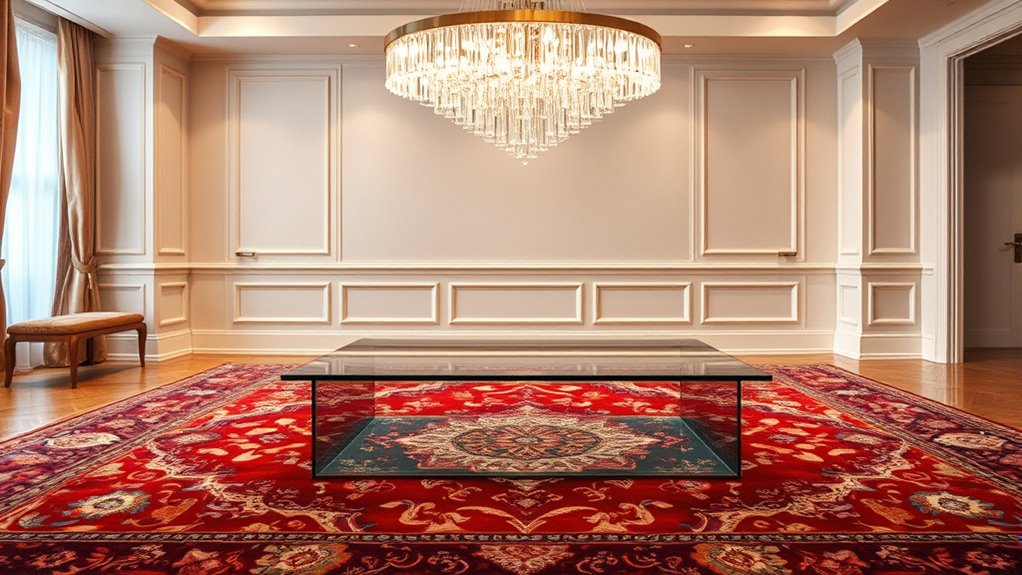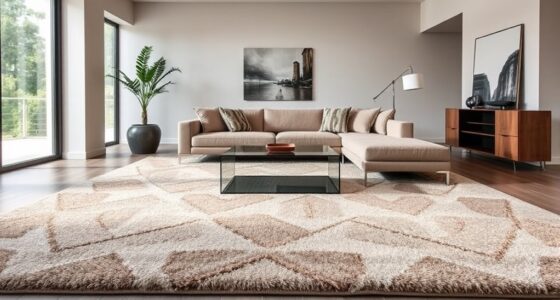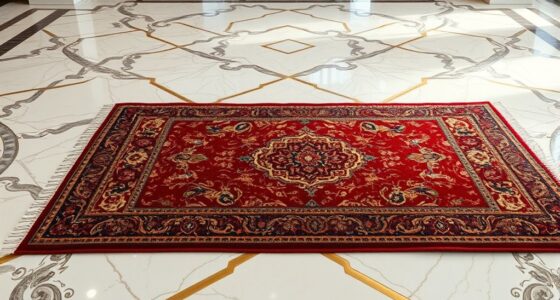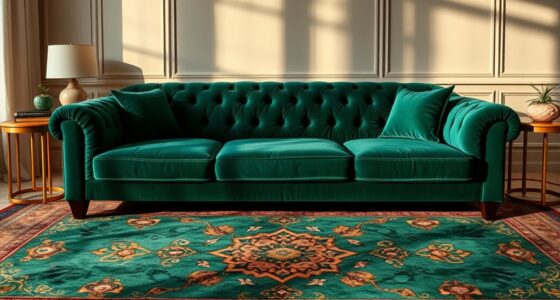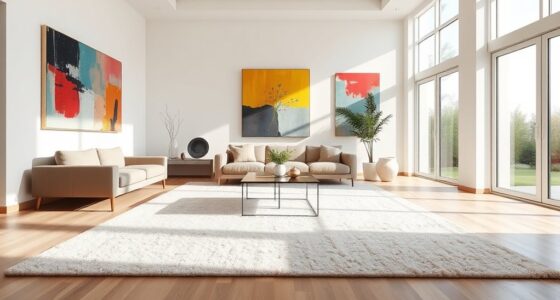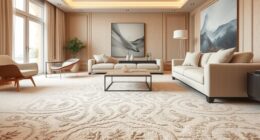When pairing rugs with statement lighting fixtures, you should consider your room’s style, mood, and scale. Choose a rug that complements the fixture’s design, whether by matching textures, colors, or patterns, to create harmony. Balance bold lighting with simpler rugs or vice versa to prevent visual clutter. Play with contrast and focus on proportion to make each element stand out. Continue exploring to discover how to master this perfect balance for stunning decor.
Key Takeaways
- Match rug patterns and colors to the style and scale of statement lighting for cohesive visual harmony.
- Use larger, bold rugs to balance oversized or dramatic fixtures, creating a focal point.
- Incorporate textured or layered rugs to add depth and complement the material and finish of lighting fixtures.
- Coordinate color schemes between rugs and lighting to enhance mood and unify the room’s design.
- Position rugs strategically to highlight key lighting features without overwhelming the overall decor.
Understanding Your Room’s Style and Mood
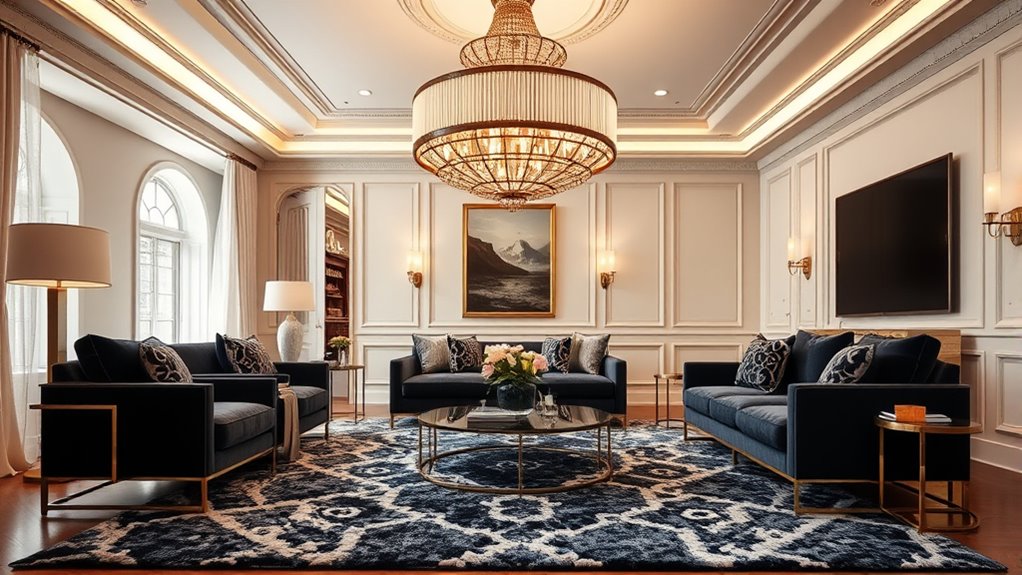
To effectively pair rugs with statement lighting fixtures, you first need to understand your room’s style and mood. If your space features minimalist decor, opt for rugs with clean lines, subtle textures, and neutral tones that complement the simplicity of your lighting. This creates a cohesive, understated look that emphasizes the statement fixture without overwhelming the room. Conversely, if your style exudes rustic charm, choose rugs with warm, earthy colors and natural materials like jute or wool. These textures add warmth and depth, enhancing the cozy, inviting atmosphere. Recognizing whether your room leans toward sleek minimalism or rustic warmth helps you select rugs that harmonize with your lighting and overall design, creating a balanced and inviting environment. Additionally, considering the farmhouse bedroom theme can guide your rug choices towards more vintage or distressed patterns that evoke rustic authenticity, further enhancing the rustic appeal of your space. Incorporating design harmony ensures that your rug and lighting choices work together seamlessly to elevate your room’s aesthetic. A thoughtful approach to color coordination also plays a crucial role in achieving visual cohesion, especially when considering the overall space organization and how each element interacts within the room.
Choosing the Right Rug Material and Pattern
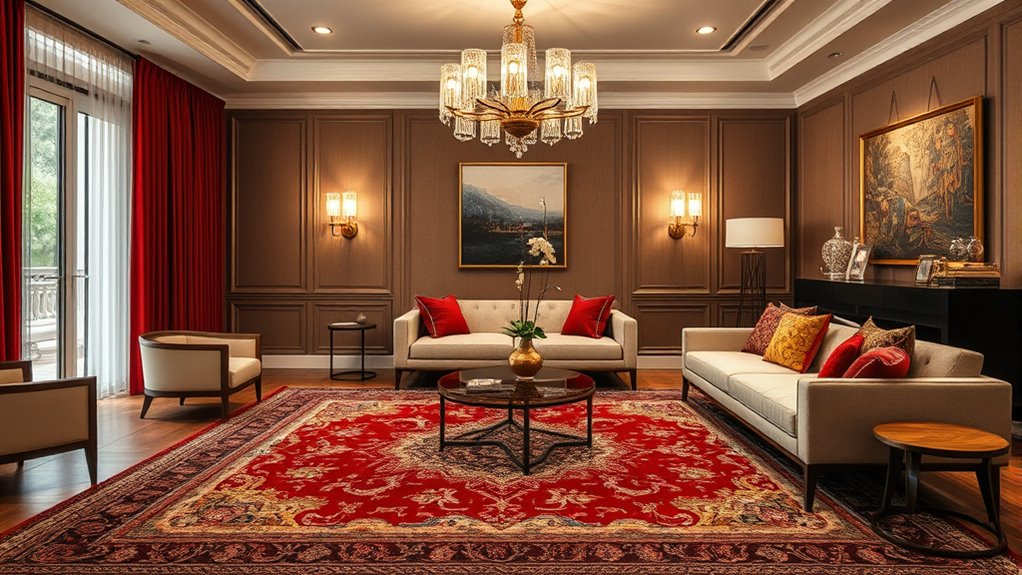
Selecting the right rug material and pattern is essential for creating a cohesive look with your statement lighting fixture. Your choice of area rugs influences the room’s texture and visual flow, so pick materials that complement your space. For high-traffic areas, opt for durable materials like wool or synthetic fibers that withstand wear. In more formal settings, silk or plush rugs add elegance. When considering rug patterns, think about scale and complexity; bold, large patterns can balance a striking fixture, while subtle designs provide understated sophistication. If your lighting fixture is modern, geometric or abstract patterns work well. For more traditional fixtures, intricate or floral designs can enhance the overall atmosphere. The key is aligning rug material and pattern with your room’s style for a harmonious look. Additionally, understanding design harmony techniques can inspire subtle decorative details that complement your lighting choices. Recognizing how interior aesthetics impact overall interior design can further refine your selections.
Selecting Statement Lighting That Complements Your Rug
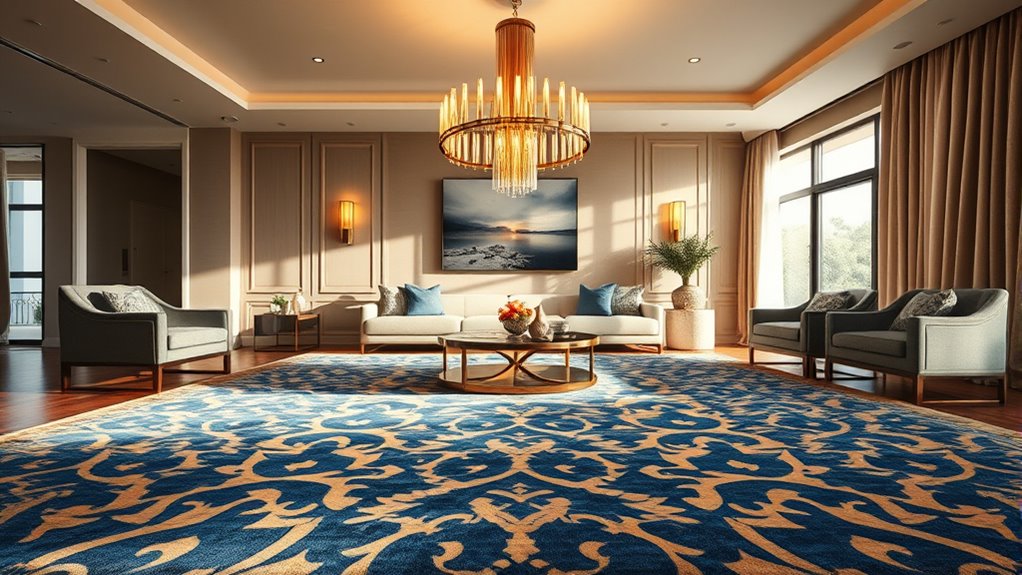
When choosing statement lighting to complement your rug, it’s important to contemplate how the fixture’s style, scale, and color interact with the rug’s pattern and material. Fixture styles vary from modern chandeliers to vintage pendants, so select one that enhances your rug’s design. A sleek, minimalist fixture works well with bold, busy patterns, while ornate fixtures suit simpler rugs. Consider the scale; a large fixture can anchor a spacious room, whereas a smaller one suits intimate spaces. Additionally, bulbs influence the mood—warm bulbs create coziness, while cool bulbs add vibrancy. Pay attention to bulb types, such as Edison or LED, to ensure the lighting complements your rug’s material and overall aesthetic. The right combination elevates your space effortlessly. Incorporating lighting fixture scale considerations ensures harmony between your statement lighting and rug, creating a balanced and inviting atmosphere. Moreover, understanding organic and natural juices can inspire eco-friendly choices for your home, from decor to lifestyle. An awareness of visual and auditory cues can further help in selecting lighting that not only looks good but also enhances the sensory experience of your space. Additionally, selecting fixtures with adjustable brightness can help tailor the ambiance to suit different occasions and moods. For example, integrating recycled materials into your lighting fixtures supports sustainable interior design practices.
Playing With Color Coordination and Contrast
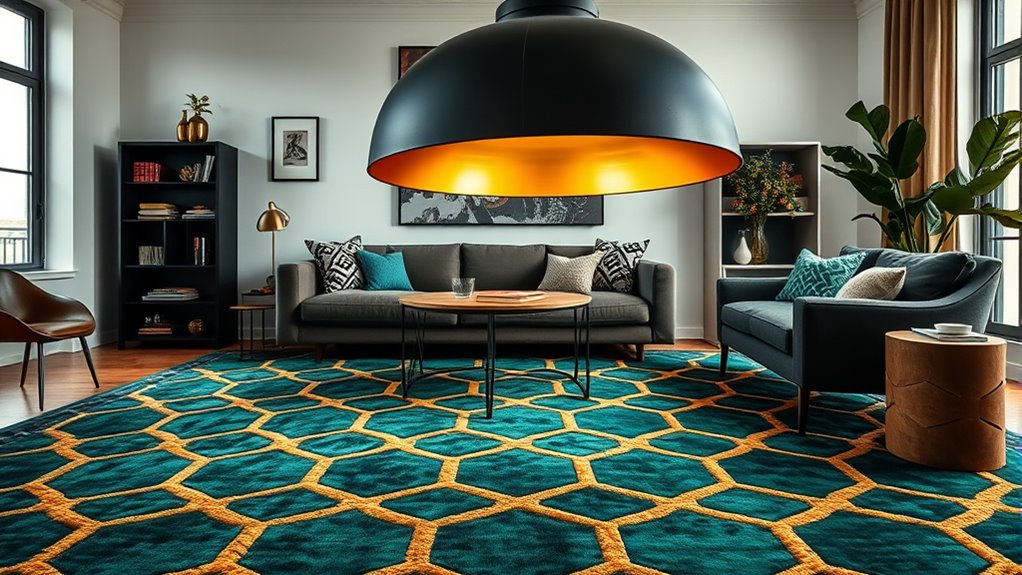
Color coordination and contrast can dramatically influence the overall vibe of your space. You can create harmony by matching rug colors with accent pillows or wall art, or introduce bold contrast for visual interest. For example, pairing a neutral rug with vibrant accent pillows adds pops of color without overwhelming the room. Conversely, contrasting a dark rug with light-colored wall art makes both elements stand out. Use the table below to explore options:
| Coordinated Colors | Contrasting Colors |
|---|---|
| Soft pastels with warm neutrals | Bright reds with cool blues |
| Monochrome schemes | Complementary color pairs |
| Similar hues for subtlety | Bold, unexpected pairings |
| Matching rugs and accent pillows | Rug and lighting fixture in contrasting shades |
Experimenting with these combinations helps you achieve the desired mood, whether calming or dynamic. Incorporating color schemes effectively can also enhance the perceived space and style of your room. Additionally, understanding the horsepower of electric dirt bikes can inspire energetic design choices, adding a dynamic touch to your decor.
Balancing Scale and Proportion for Visual Harmony
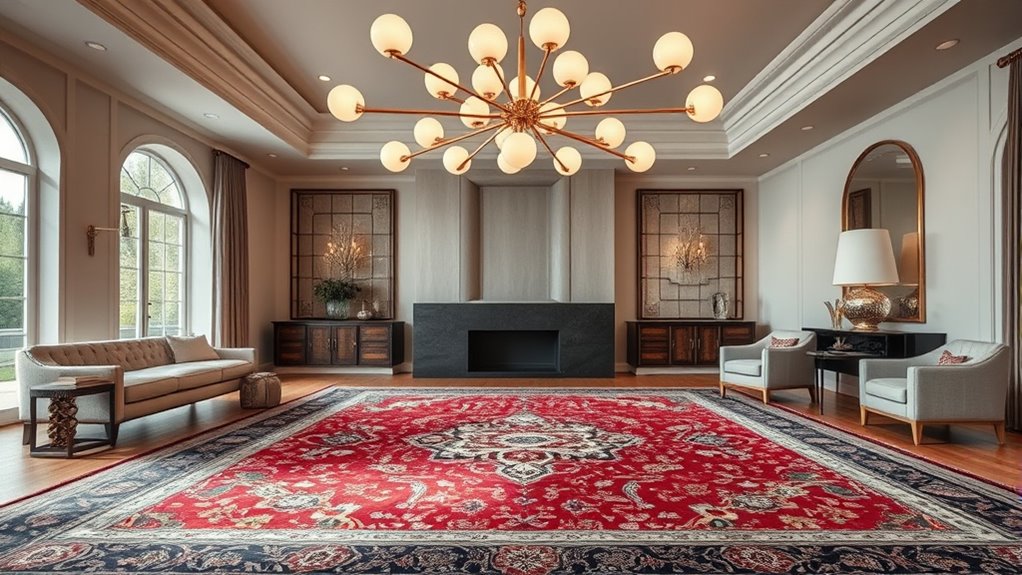
Achieving visual harmony in your space depends heavily on balancing the scale and proportion of your rugs and lighting fixtures. To create this balance, consider these key points:
- Choose an area rug that complements the size of your room, avoiding rugs that are too small or overwhelming.
- Select statement fixtures that are proportionate to the furniture and room dimensions, ensuring they don’t overpower or get lost.
- Position your lighting fixtures so they highlight the area rug without dominating the space, maintaining an even visual flow.
- Incorporate AI-powered design tools to simulate different rug and lighting combinations, helping you visualize the perfect balance before making a purchase.
Creating Focal Points With Layered Lighting and Rugs

Layered lighting combined with strategically placed rugs can transform a room into a compelling focal point. Use rugs with geometric patterns to add visual interest and define specific areas. Natural fibers like jute or sisal create a warm, organic foundation that complements layered lighting. By placing rugs beneath statement fixtures or in key seating zones, you draw attention and anchor the space. Layered lighting—combining ambient, task, and accent lights—highlights the rug’s design and emphasizes its role in the room’s aesthetic. The interplay of light and pattern guides your eye, making the rug a central feature. This approach not only enhances visual appeal but also creates a cozy, inviting atmosphere that naturally becomes the room’s focal point.
Incorporating Textures for Depth and Interest

Adding different textures to your space creates visual interest and makes it feel more inviting. You can layer tactile elements like plush rugs or woven fabrics to add depth, while contrasting surfaces keep the look dynamic. Experimenting with these textures helps your lighting and rugs work together to craft a more engaging atmosphere.
Layering Textural Elements
Incorporating a variety of textures into your space creates visual interest and makes your decor feel more inviting. This technique, known as textural layering, adds depth and richness to your environment. To achieve this, consider these elements:
- A plush velvet sofa that invites touch and contrasts with smooth glass tables.
- Woven baskets or throws that add tactile contrast against sleek surfaces.
- Soft, shaggy rugs layered beneath sleek, polished floors to create depth.
Contrasting Tactile Surfaces
Contrasting tactile surfaces can instantly elevate the depth and visual interest of your space. By combining different textures, you create a compelling textural contrast that draws the eye and invites touch. Think about pairing a plush rug with a sleek, smooth leather chair or a rough stone accent wall with a soft fabric curtain. This tactile interplay adds dimension and richness, making your room feel more dynamic. When selecting materials, focus on how different surfaces interact—rough versus smooth, soft versus hard—to craft a layered, engaging environment. Using contrasting textures intentionally brings energy and balance, ensuring your space feels thoughtfully curated. This approach makes your lighting fixtures and rugs work harmoniously, adding depth through the diverse tactile experiences you incorporate.
Considering Functionality and Lighting Placement

Start by evaluating your room’s lighting needs to guarantee your space is bright and inviting. Consider how your rug’s features can be highlighted with the right fixture placement. Finally, optimize your lighting to enhance both functionality and the aesthetic appeal of your rug and statement piece.
Assess Room Lighting Needs
Before choosing rugs and lighting fixtures, you need to assess your room’s lighting needs by considering how the space is used and where natural light enters. Think about creating an ambient glow and shadow play that enhances the room’s mood. To do this, consider:
- The placement of windows and how much daylight filters in during the day.
- The activities you do in the space, like reading or entertaining, which require focused or soft lighting.
- The areas that need extra illumination, such as corners or darker zones, where statement lighting can add depth.
Highlight Rug Features
When selecting a rug, it’s essential to take into account how its features interact with your room’s lighting placement and functionality. Consider rug durability, especially if your space experiences high foot traffic or frequent use, as this affects long-term performance. A durable rug withstands wear and tear while maintaining its appearance under different lighting conditions. Additionally, think about rug cleaning techniques; some materials require specific care to keep them looking fresh and vibrant. Proper cleaning not only preserves the rug’s color and texture but also prevents damage from light exposure and dust. By highlighting these features, you guarantee your rug complements your statement lighting fixture effectively, enhancing your room’s overall aesthetic and practicality.
Optimize Fixture Placement
Optimizing fixture placement is essential for guaranteeing both functionality and aesthetic harmony in your space. Proper fixture placement guarantees your lighting highlights the rug’s features while providing practical illumination. To achieve this, consider these three steps for ideal positioning:
- Position fixtures directly above key areas, like seating or focal points, to create balance.
- Guarantee lighting is evenly spaced to prevent dark corners or overly bright spots.
- Adjust height and angle to enhance the rug’s design without causing glare or shadows.
Mixing Modern and Traditional Elements Effectively

Blending modern and traditional elements can create a dynamic and personalized space, but achieving harmony requires deliberate choices. Incorporate vintage accents to add character and authenticity, balancing them with sleek, contemporary statement lighting fixtures. Use geometric patterns in rugs or accessories to bridge the gap between eras, creating visual interest without clashing. Focus on color palettes that complement both styles, such as neutral tones with bold pops of color. Keep the overall design cohesive by selecting pieces that share similar materials or finishes. For example, pairing a vintage-inspired rug with a modern chandelier works best when their textures and tones align harmoniously. Remember, the goal is to blend, not overpower—let each element enhance the other for a polished, inviting space.
Tips for Maintaining Balance in a Bold Decor Scheme

To keep your bold decor balanced, focus on coordinating colors so everything feels harmonious. Pay attention to scale and proportion to prevent any one element from overpowering the space. By highlighting key pieces, you can create a focal point that guides the eye and maintains visual stability.
Balance Through Color Coordination
When working with bold decor schemes, color coordination becomes essential to create a sense of harmony. Achieving color harmony helps establish visual balance, preventing the space from feeling overwhelming. To do this effectively, consider these steps:
- Choose a dominant color that anchors the room and complements your statement lighting and rug.
- Incorporate secondary colors that support the main hue without clashing, creating subtle contrast.
- Use accent colors sparingly to highlight specific areas or features, adding depth without disrupting harmony.
Scale and Proportion Tips
Maintaining the right scale and proportion is crucial when pairing bold decor elements like statement lighting and rugs. To create harmony, ensure your area rugs complement the size of your lighting fixtures. Oversized lighting can overwhelm small rugs, while tiny fixtures might get lost on large rugs. Use proportion rules like choosing a rug that extends beyond furniture edges or matching fixture size to room dimensions. Here’s a quick guide:
| Room Size | Rug Size | Lighting Fixture Size |
|---|---|---|
| Small | Smaller | Smaller |
| Medium | Medium | Medium |
| Large | Larger | Larger |
| Open Plan | Large | Statement |
This table helps you balance scale, so your bold decor feels cohesive rather than chaotic.
Highlighting Key Elements
In a bold decor scheme, highlighting key elements guarantees that statement pieces enhance rather than overwhelm your space. To maintain balance, focus on three main strategies.
- Choose a dominant piece—such as a striking rug or an artistic lighting fixture—that anchors your room and reflects your cultural symbolism.
- Use subtle accessories or neutral colors nearby to let your key elements stand out without cluttering.
- Incorporate textures and patterns thoughtfully, ensuring they complement your statement pieces without competing.
This approach allows your artistic expression to shine through while keeping the overall design cohesive. By emphasizing what’s most meaningful—be it cultural symbolism or personal flair—you create a space that’s both visually engaging and balanced.
Frequently Asked Questions
How Do I Choose Lighting Fixtures for Low-Ceiling Rooms?
When choosing lighting fixtures for low-ceiling rooms, focus on enhancing the space without overwhelming it. Select flush or semi-flush mounts to keep the ceiling height feeling open, and avoid hanging fixtures that hang too low. Proper lighting placement is key; position fixtures centrally or along the perimeter to evenly distribute light. This approach helps make the room feel brighter and more spacious, despite the lower ceiling height.
What Are the Best Rug Styles for Small Spaces?
Thinking about the perfect rug for your small space? You’ll want to opt for styles that make the room feel larger and more inviting. Light-colored rugs with subtle patterns work well, creating a sense of openness through thoughtful color coordination. Choose rugs with interesting material contrast—like a soft wool with a sleek silk border—to add depth and texture without overwhelming your cozy area. This balance keeps your space stylish and comfortable.
Can Statement Lighting Work in Minimalist Interiors?
You can definitely use statement lighting in minimalist interiors to create ambient and mood lighting. Choose fixtures with sleek, simple designs that add visual interest without overwhelming the space. These bold lights become focal points, enhancing the room’s aesthetic. Pair them with neutral decor and subtle rugs to maintain minimalism while adding a touch of personality. This balance keeps your space feeling both serene and stylish, perfect for a modern, minimalist vibe.
How Do I Prevent Rugs and Lighting From Clashing?
To prevent rugs and lighting from clashing, focus on color coordination and material harmony. Choose a rug with neutral or complementary tones that match your room’s palette, and select lighting fixtures that either blend seamlessly or serve as subtle accents. Avoid overly busy patterns or high-contrast colors. By balancing these elements thoughtfully, you create a cohesive look that feels intentional and stylish, without any visual discord.
What Lighting Options Enhance Textured Rugs Effectively?
To enhance textured rugs effectively, you should choose lighting that creates an ambient glow and accent highlights. Opt for warm, soft lighting like dimmable wall sconces or table lamps to bring out the rug’s texture without overwhelming it. Avoid harsh or overly bright fixtures, which can flatten the rug’s details. Instead, use layered lighting to add depth and warmth, making your textured rug a true focal point of the space.
Conclusion
So, next time you think more is more, remember that pairing bold rugs with statement lighting is all about balance—unless you’re aiming for chaos. Sometimes, a carefully chosen rug and fixture can turn your space into a masterpiece, but don’t be surprised if it’s the subtle details that steal the show. After all, who knew that a little restraint could make your daring decor truly shine? Irony, right?
